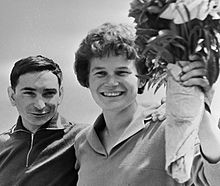Vostok 6
| Mission dates | |||||||
|---|---|---|---|---|---|---|---|
| Mission: | Vostok 6 | ||||||
| COSPAR-ID : | 1963-023A | ||||||
| Spacecraft: | Vostok | ||||||
| Dimensions: | 4720 kg | ||||||
| Call sign: | Чайка (Chaika - " seagull ") | ||||||
| Crew: | 1 | ||||||
| Begin: | June 16, 1963, 09:30 UT | ||||||
| Starting place: | Baikonur 1/5 | ||||||
| Landing: | June 19, 1963, 08:20 UT | ||||||
| Landing place: | 620 km NE of Karaganda 53 ° 16 ′ N , 80 ° 28 ′ E |
||||||
| Flight duration: | 2d 22h 50min | ||||||
| Earth orbits: | 48 | ||||||
| Rotation time : | 88.34 min | ||||||
| Orbit inclination : | 65.09 ° | ||||||
| Apogee : | 218 km | ||||||
| Perigee : | 168 km | ||||||
| Covered track: | 1.971 million km | ||||||
| ◄ Before / After ► | |||||||
|
|||||||
Vostok 6 was a manned space flight as part of the Vostok program of Soviet space travel . With the cosmonaut Valentin Tereschkowa , a woman flew into space for the first time.
crew
- Valentina Vladimirovna Tereshkova (1st flight)
Substitute team
Support team
preparation
The idea of training female cosmonauts was born in 1961, shortly after Yuri Gagarin's historic flight . The project was controversial within the Soviet space agencies and in the military. Since there were few female pilots, the search was extended to female parachutists. On February 16, 1962, five Russian women were selected from 58 candidates to form the second cosmonaut group in the USSR:
- Sanna Dmitrijevna Jerkina
- Tatiana Dmitryevna Kuznetsova
- Valentina Leonidovna Ponomaryova
- Irina Bajanovna Solovyova
- Valentina Vladimirovna Tereshkova
After the double flight of Vostok 3 and Vostok 4 in August 1962, it was not clear how many more Vostok flights would take place and how many of them would be manned by female cosmonauts. In spring 1963 it became clear that no new Vostok spaceships would be manufactured. The two remaining single-seat spaceships would be used for a double flight with a man and a woman.
After Tatiana Kuznetsowa had failed the theory test to become a cosmonaut in November 1962, Sanna Jerkina also dropped out in May 1963 for health reasons.
On June 4, 1963, Valentina Tereschkowa was confirmed as the crew for Vostok 6, with Valentina Ponomarjowa and Irina Solowjowa as reserves.
Flight history
Vostok 6 took off on June 16, 1963 at 12:29 p.m. Moscow time from the Baikonur rocket launch site and after a few minutes reached Earth orbit with 165 km perigee and 166 km apogee at an inclination of 65 degrees.
During the first orbit around the world, Vostok 6 and Vostok 5 approached within about 5 kilometers as planned. Vostok 5 with Valery Bykowski on board had started two days earlier.
During the first day Tereschkowa was able to maintain direct radio contact with Bykowski, but the two spaceships were increasingly distant, and from the second day the connection was only possible via relay stations on earth. The Vostok spaceships only had attitude control options and could not influence their orbit themselves. The rendezvous between the two spaceships was not based on active control, but based on precise calculations before take-off.
Tereshkova took photos and films of the earth. A biological experiment was left unfinished because she couldn't reach the equipment.
The braking rockets were ignited as planned, as was the dropping of the equipment section. The flight control received this information, however, only via telemetry , because Tereschkowa did not report on the radio.
After almost three days of space flight, the landing took place on June 19, 1963 at 08:20 GMT about 620 km northeast of Karaganda in what is now Kazakhstan . As usual with the Vostok flights, Tereschkowa catapulted himself out of the landing capsule with an ejector seat and landed on a parachute .
meaning

In the following years, Tereshkova appeared very often in public. She went on several trips abroad for press conferences and lectures.
After the first launch of a satellite ( Sputnik 1 , 1957 ), the first manned space flight ( Wostok 1 , 1961 ) and the first double flight ( Wostok 3 / Wostok 4 , 1962 ), the Soviet Union had once again made a first service. The first flight of a female space traveler was a worldwide prestige for the USSR. It was not until 1982 that a woman, Svetlana Savitskaya , would fly into space again.
Despite landing problems, Vostok 5 and Vostok 6 formed a successful conclusion to the Vostok program. It had already been decided that the next manned flights would be carried out with a further development, the multi-seat Vozhod spaceships . The Soyuz spaceship , which was completely redesigned, should not be available for several years.
The return capsule is exhibited today in the RKK Energija Museum in Kaluga .
Web links
- Wostok 6 at spacefacts.de
- Vostok 6 at space.kursknet.ru (English / Russian , archived 2016)
- Wostok 6 in the Encyclopedia Astronautica (English)
- Wostok 6 in the NSSDCA Master Catalog (English)
- Sven Grahn: The flight of Vostok-5 and Vostok-6 as Observed in radio intercept (English)
